High Renaissance in Italy (Unit 1)
1/73
There's no tags or description
Looks like no tags are added yet.
Name | Mastery | Learn | Test | Matching | Spaced |
|---|
No study sessions yet.
74 Terms
High Renaissance
Similar social/economic/political situation in Italy as it was during the Early Renaissance: competing autonomous city-states and a powerful pope. Features the most famous Renaissance artists and works.
Generational shift
Transition in artists from one generation to another between the 1400s and the 1500s. Used as the distinction between the Early Renaissance and the High Renaissance.
Leonardo
Renaissance man known for diverse talents and genius: poetry, music, engineering, painting, and more. Considered one of the greatest artists of all time during his lifetime. Developed a reputation as “mysterious.” Experimental. Known for his analytical, slow process. Oil paint appealed greatly to him, and he was one of the first Italian artists to use it. Vasari argued that his multitude of skills was a gift from God.
Renaissance man
Multi-talented individual excelling in various fields.
Vasari
Florentine author of the most famous biography of the Renaissance. Lauded the artistic prowess of the likes of Leonardo and Michelangelo
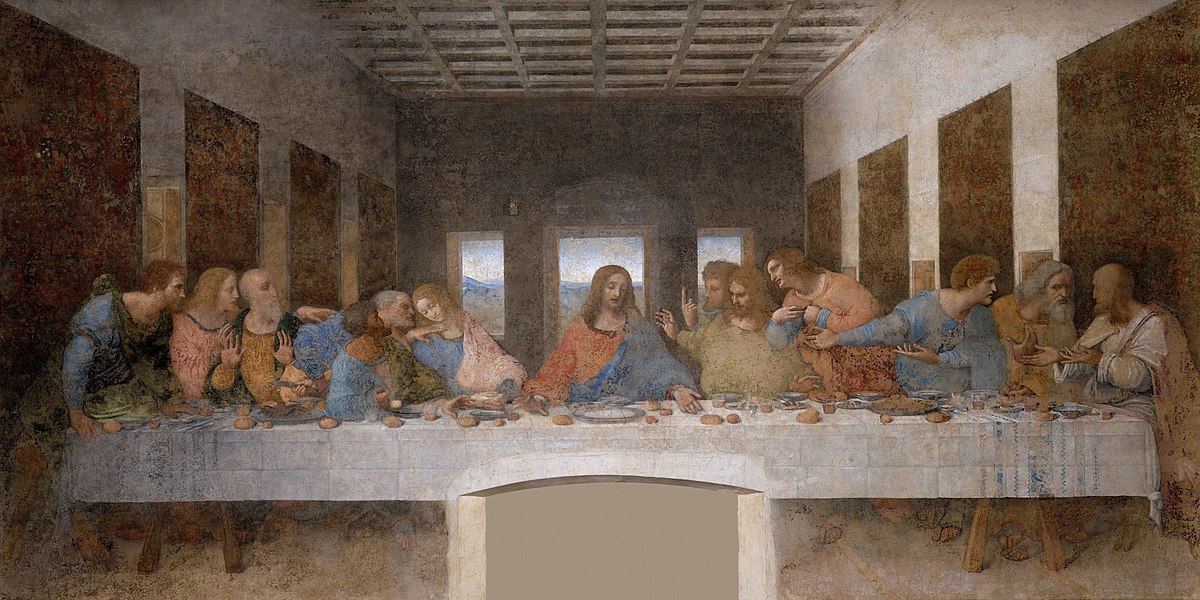
Last Supper
Famous experimental painting by Leonardo where he attempted to combine tempera, oil paint, and fresco. The paint was fragile and not long-lasting as a result. Showcases the quality of Leonardo’s work. Seamless combination of a rational, precise structure and naturalism. Compositionally uses Jesus as a vanishing point and aligns all disciples with his eyes (escalating Early Renaissance techniques of perspective). Uses a triangular structure throughout.
Tempera
Fast-drying painting medium using pigments and water.
Oil paint
Slow-drying medium allowing for detailed artwork. Favored by slow-working artists such as Leonardo.
Fresco
Technique of mural painting on freshly applied plaster. Incredibly quick-drying. Requires daily-mixing, so it is sometimes possible to tell where the day’s work for an artist stopped and began based on differences in color shades.
Backward writing
Leonardo's unique left-handed writing style to avoid smudging the ink of his pens. Mistaken for codes.
Experimental artist
Artist who innovates and tries new techniques.
Michelangelo
Famous sculptor and painter of the High Renaissance.
Raphael
Noted painter known for his harmonious compositions.
Pope's power
Significant influence of the Pope during the Renaissance.
1500s
Time period defining the High Renaissance in Italy.
Artistic maturity
Peak skill level reached by artists in their careers.
Diversity of talents
Leonardo's ability across multiple artistic disciplines.
Anatomical studies
Leonardo's investigations into human body structure.
Elder statesman
Leonardo's status as a respected, older artist.
Horizon Line
Line running through Jesus's eyes in Last Supper.
Vanishing Point
Central point for perspective.
Orthogonals
Lines converging at vanishing point to create depth.
Mathematical Perspective
Precise use of perspective techniques in art.
Triangular Composition
Structure using triangles for stability and balance. Used by Leonardo in the Last Supper.
Naturalism
Artistic style emphasizing realistic representation. Leonardo was praised through his use of this alongside rational and precise structure (using sfumato and chiaroscuro to elevate the effect).
Sfumato
Technique creating hazy, smoky transitions in painting. A misty quality present in all of Leonardo’s work. Not exactly self-focused; often described as the figures emerging out of a mist or fog.
Chiaroscuro
Technique using light and shadow for depth. A subtle transition from areas of light to areas of shadow.
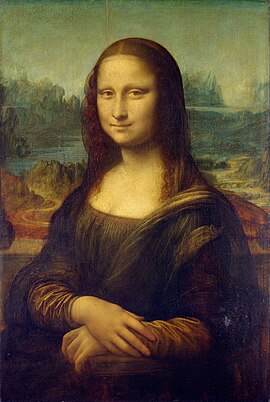
Mona Lisa
Oil on panel portrait of an upper-class Florentine woman. Leonardo’s most famous work well-known for its mysterious smile. Supposedly required clowns and jesters to keep its subject entertained during Leonardo’s incredibly long process.
Raphael
Big Renaissance artist known for clarity in art. Spent most of his career between Florence and Rome. First started out doing small Madonna paintings. Prioritized beauty and refinement in his art. Obsessed over the concept of “disegno.” Had a reputation as a “gentleman artist.”
Madonna Paintings
Early works by Raphael depicting the Virgin Mary.
Rich Colors, sfumato, and chiaroscuro
Vivid hues and techniques used in many Renaissance oil paintings by Rafael’s time.
Clarity and Directness
Raphael's artistic goal contrasting with Leonardo's style.
Early Renaissance
Period when perspective techniques began to evolve.
Artistic Genius
Leonardo's ability to blend structure with naturalism.
Composition
Arrangement of elements in a work of art.
Disegno
Conceptual approach to art design and composition. Directly translates to “design.” During the High Renaissance, if an artwork possessed this quality, it was imprinted onto the viewers’ intellect. A well-designed work of art was believed ot make one a more rational and intellectual person.
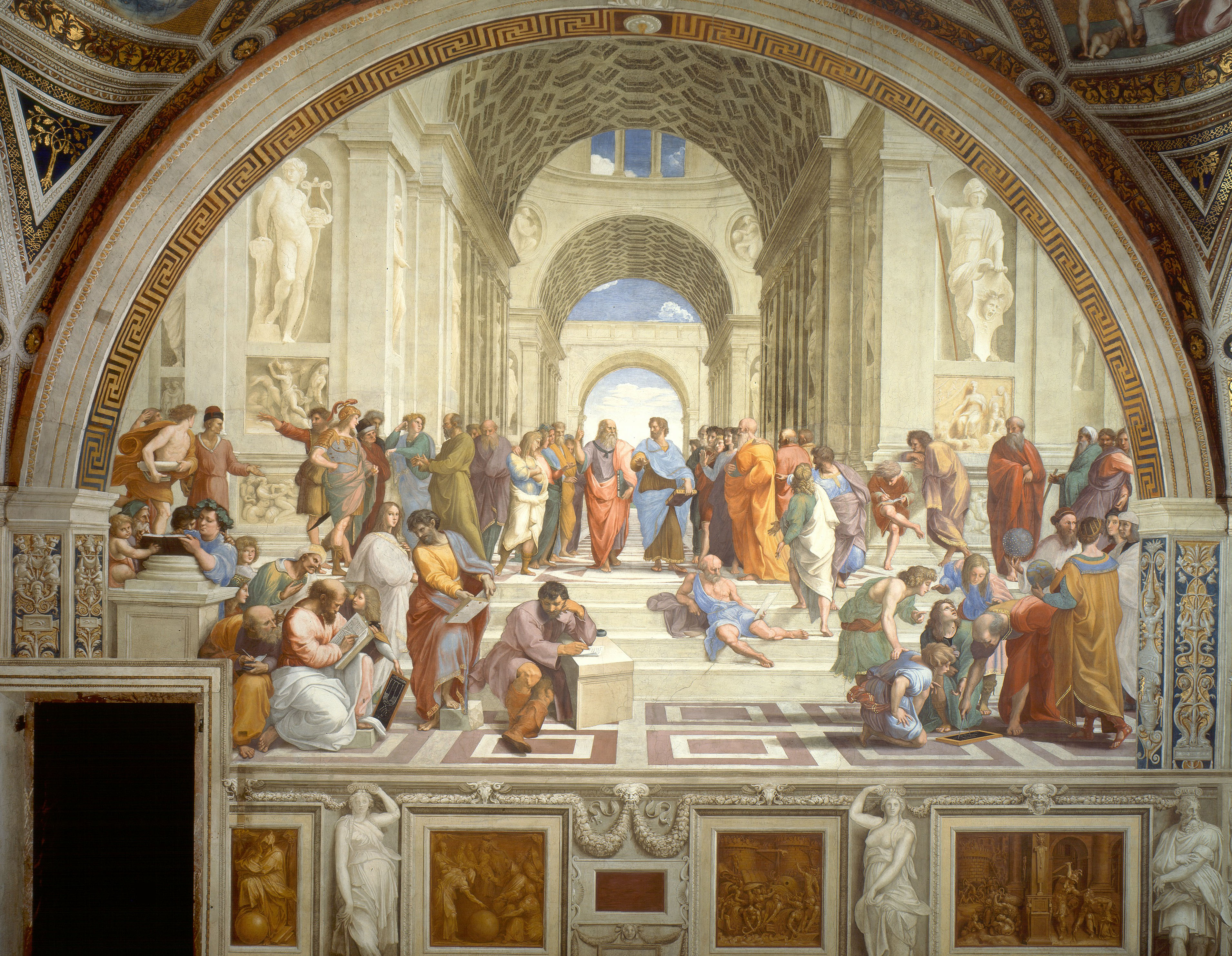
The School of Athens
Fresco by Raphael showcasing classical philosophers and artists. Although abundant, they are organized in a way that the piece looks harmonious and dignified. Commissioned for the interior of waiting rooms for the pope. Contains portraits of Plato/Leonardo, Aristotle, a self-portrait, Michelangelo/Heraclites, and more.
Papal Commission
Artworks commissioned by the pope.
Fresco
Technique of mural painting on wet plaster.
Renaissance Popes
Church leaders often raised in humanist environments.
Intellectual Development
Art viewed as a means to enhance intellect.
Cultural Integration
Blend of classicism and humanism in Renaissance society.
Michelangelo
Pinnacle artist, revered above Leonardo and Raphael during his lifetime. His importance for later art manifested in how he was seen as a model to being a good artist. Considered himself first and foremost as a sculptor but also painted. Vasari claimed he was sent to teach other artists how to attain perfection. Chose to work intuitively in contrast to Leonardo and saw his sculpting as “freeing the form” (a rather modern concept).
“The Divine Michelangelo”
Michelangelo’s nickname - a result of his reputation as an art genius saving fellow artists from their errors. A testament to the magnitude of his influence on the art world.
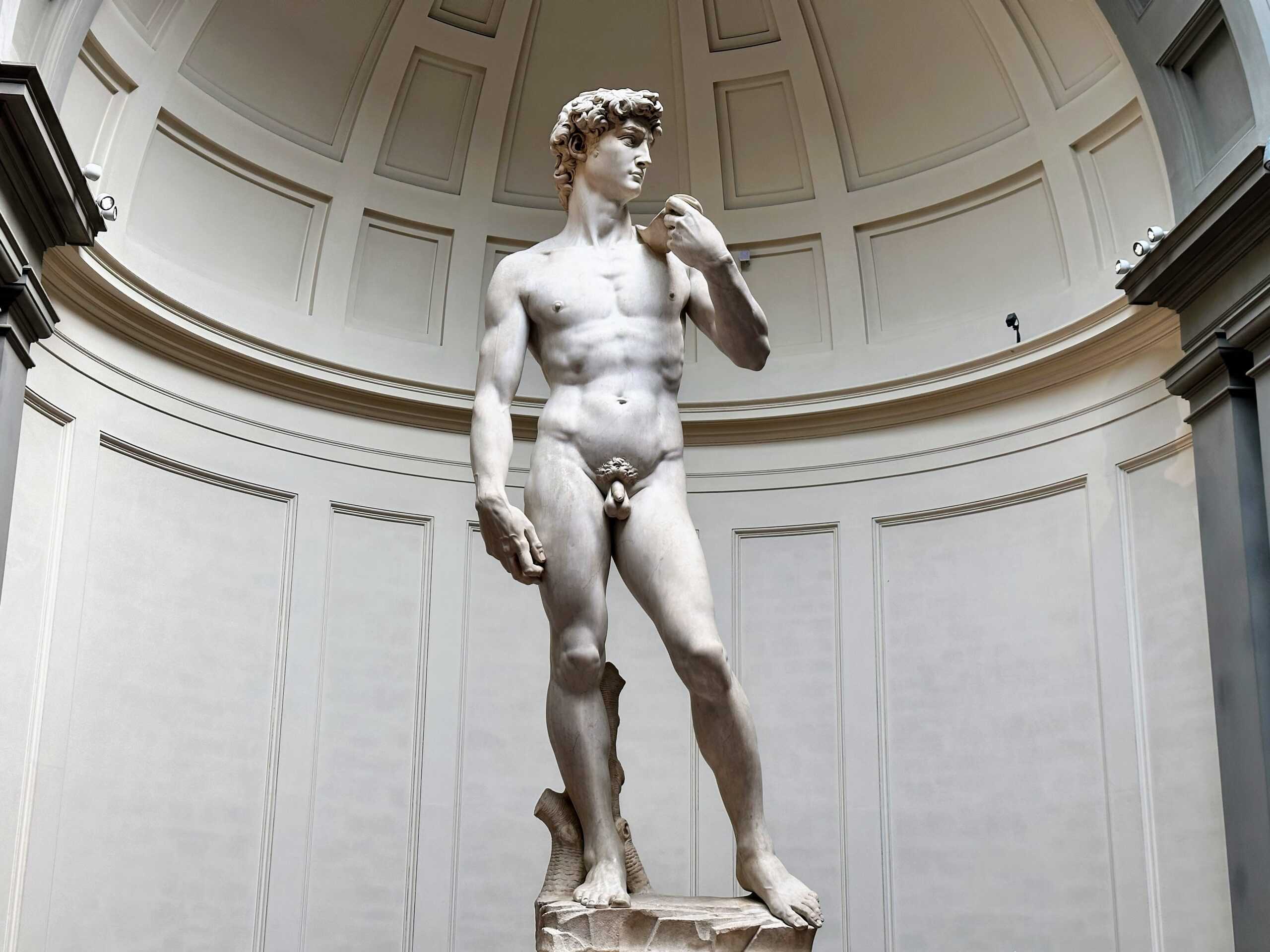
David
Michelangelo's iconic sculpture symbolizing Florence. Interestingly depicts David during a moment of stillness where he decides he will fight Goliath (posing this as the moment he truly became a hero). Michelangelo miraculously sculpted David with a sense of energy and a possibility of movement in marble. Exceptionally correct anatomy other than out-of-proportion hands (a result of either Michelangelo’s obsession with sculpting hands as a testament to his skill or the fact that the statue was meant to be seen from below).
Polykleitos
Ancient sculptor influencing Michelangelo's artistic style.
Mature male nude
Acceptable representation in art during Michelangelo's time.
Slingshot
Weapon David carries, signifying his readiness to fight.
Goliath
Giant adversary David prepares to confront. Symbolizes Milan in Florentine renditions.
Florence
City-state commissioning Michelangelo's David sculpture.
Artistic cues
Influences Michelangelo drew from classical art.
Marble Quarries
Locations where Michelangelo selected unclaimed marble blocks.
Constant Revision
Leonardo's practice of restarting work for perfection.
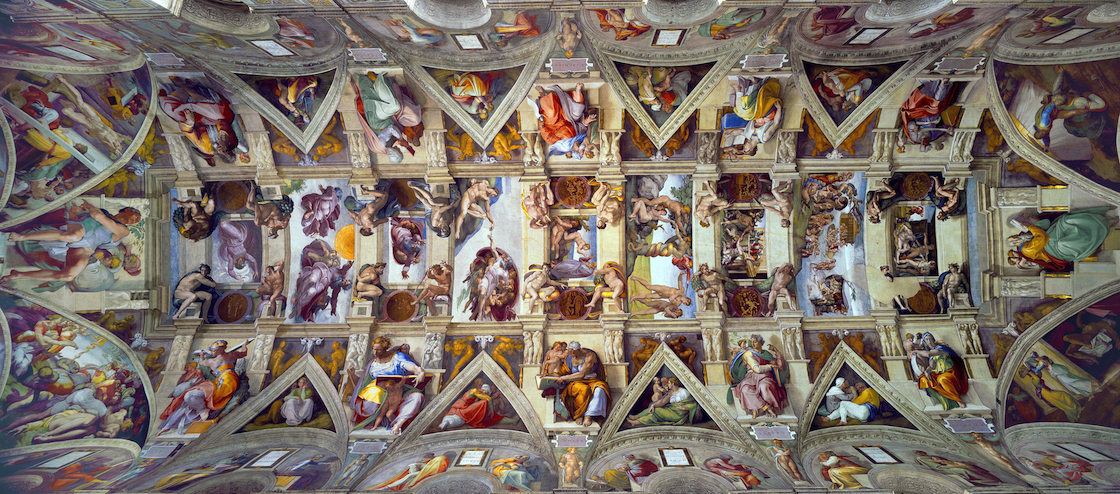
Sistine Chapel Ceiling
Famous frescoes painted by Michelangelo for the Pope despite the fact that the former was not a painter. Supposedly had a workshop to assist him (as was typical of artists at the time) but then fired them after a single panel and did the rest himself. The amount of scaffolding he would have had to use is a testament to his determination. Contains narrative scenes in the center and various stories about the creation of the world from the book of Genesis.
Artist Workshops
Renaissance practice of artists managing teams and apprentices. Following the system, the work would always be accredited to the master artist regardless of the division of labor (this was a known and accepted fact by patrons).
Full-Sized Drawings
Poking holes technique used by Michelangelo for ceiling figure outlines.
Artistic Spirit
Concept of material possessing inherent artistic qualities.
Trompe l'oeil
Art so realistic it “fools the eye.” Used in Michelangelo’s frescos on the ceiling of the Sistine Chapel to create the illusion of marble arches.
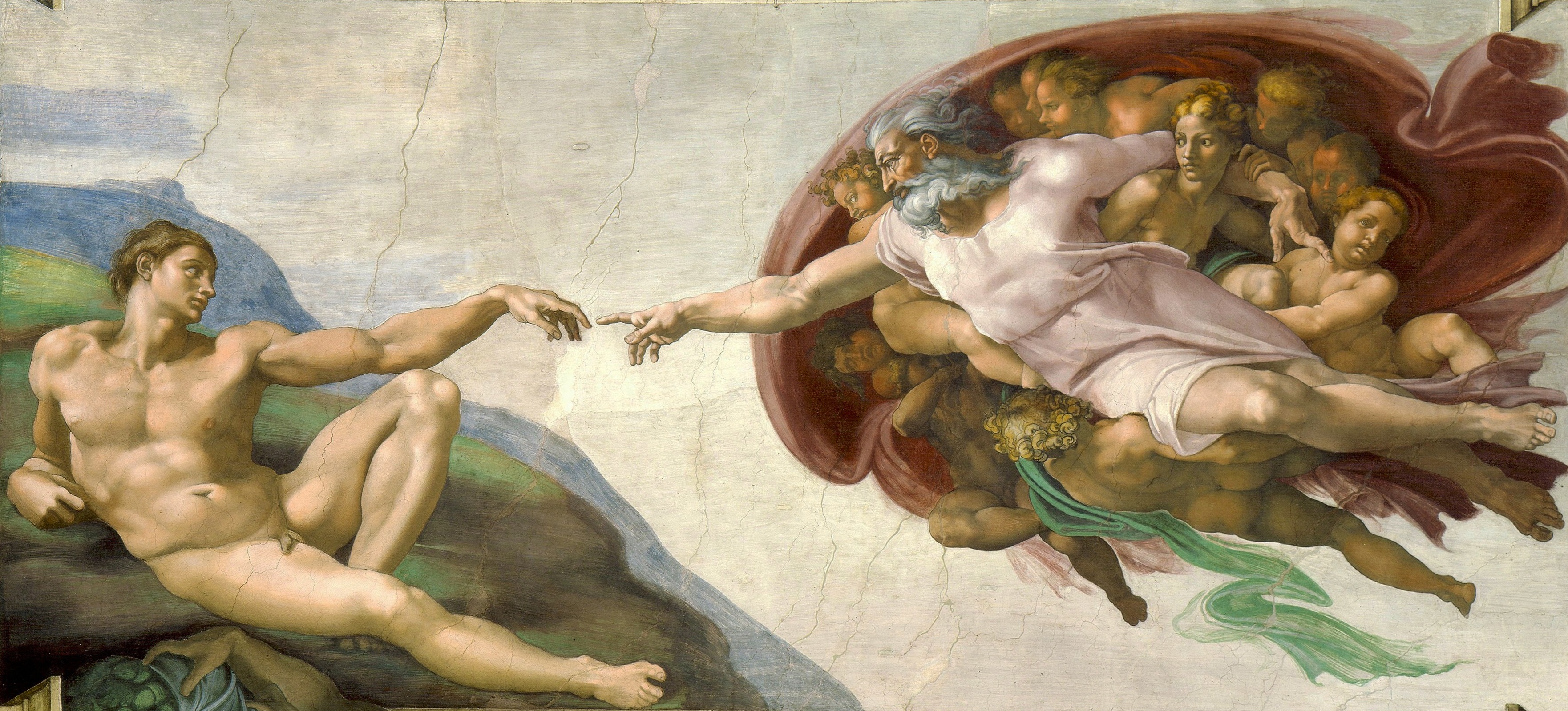
The Creation of Adam
Michelangelo’s most famous narrative on the ceiling of the Sistine Chapel. Features God the Father giving the spark of life to Adam. Demonstration that Michelangelo’s understanding of the human body is informed by classical sculpture; he applied principles he learned in sculpture to his paintings, giving them a unique look compared to other Renaissance paintings of humans. This limited his body diversity, but his mastery of the classical body was nonetheless enormously influential.
Classically-inspired Nude
Idealized male body representation by Michelangelo.
Venetian School
AKA the Venetian High Renaissance. Distinct art movement during the Italian High Renaissance. Trended toward secular and classical subjects, as the church is less powerful than it is in Rome and Florence.
Venice
The place that Leonardo is believed to have picked up oil painting from. An international city of trade with strong connections to Northern Europe. Also known for its festivities.
Oil on Canvas
Painting technique popularized by Venetian artists who picked it up from Northern Europe.
Giorgione
Prominent artist of the Venetian Renaissance. A master artist.
Titian
Major figure in Venetian Renaissance painting. Began as an apprentice to Giorgione but eventually became a master himself.
Pastoral
An idealized landscape. Enormously popular in Venice, especially among wealthy Venetians who often owned a city apartment and a country home. Became fashionable to decorate urban apartments with these scenes.
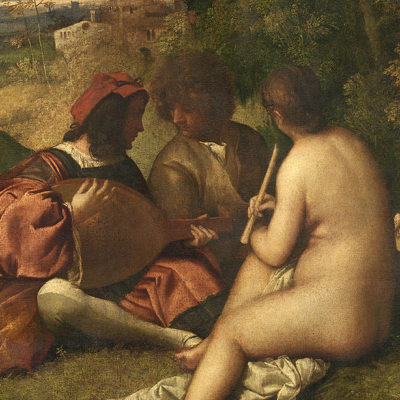
Pastoral Concert
Influential work credited to Giorgione and Titian. An image of two guys composing music who are inspired by two classical muses (responsible for inspiring artists). An example of two distinct Venetian aesthetics: a Sfumato-like, golden smokiness and its sensuousness (mainly focused on sounds), both amplified by its velvety brush strokes.
Architectural Framework
Structural design surrounding figures in artwork.
Golden Smokiness
Sfumato-like. Characteristic light quality in Venetian paintings.
Sensuousness
Art appealing to the senses, enhancing viewer experience. Characteristic quality in Venetian paintings.
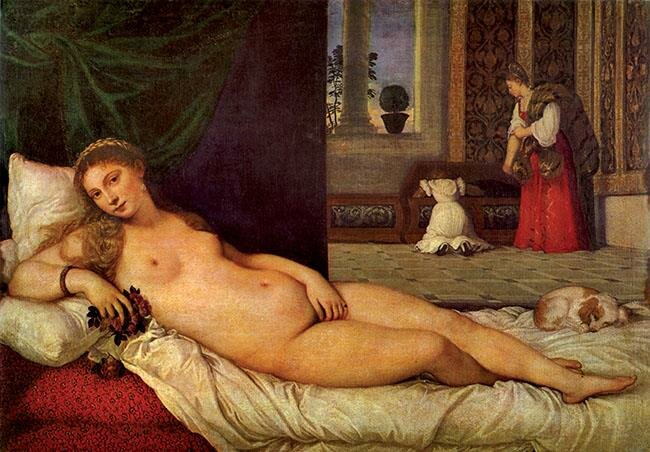
Venus of Urbino
Titian's iconic nude portrait. Although there is debate over where it depicts a real person, the sleeping dog suggests it is a mistress of the Duke of Urbino (its patron). Thought of as the standard for the female nude in Western art. Has a haziness and sensuous quality (scent and sound).
Venus Pudica
Modest pose covering genitals meant to be modest yet draws the viewer’s attention to the area it conceals. Discussed as false modesty. Seen in Venus of Urbino.
Dog
Symbolically represents fidelity in Venus of Urbino painting; asleep.
Secular Art
Art commissioned by non-religious patrons in Venice. Allowed for greater exploration of mythology.